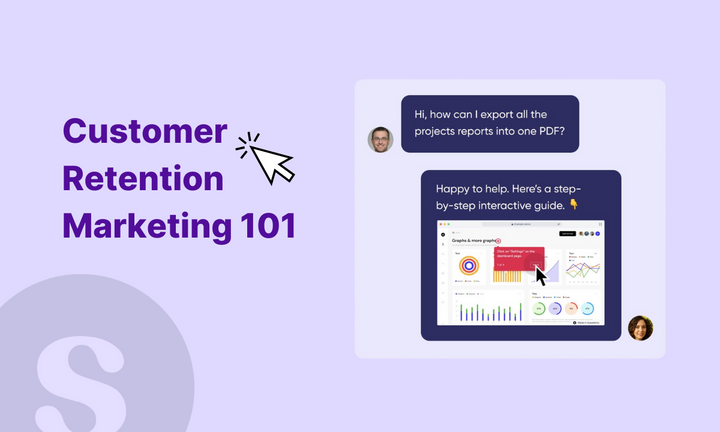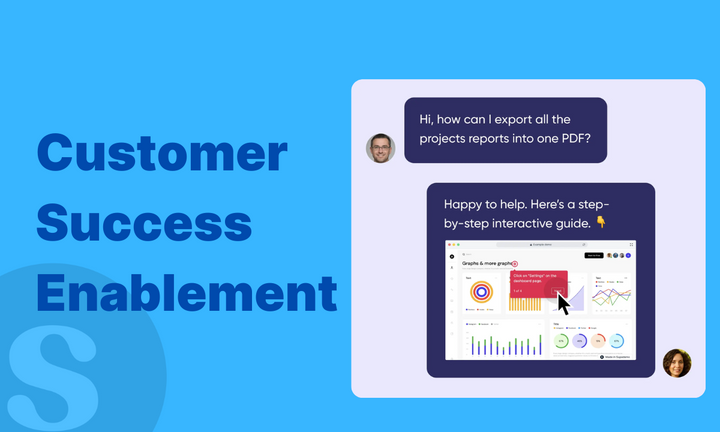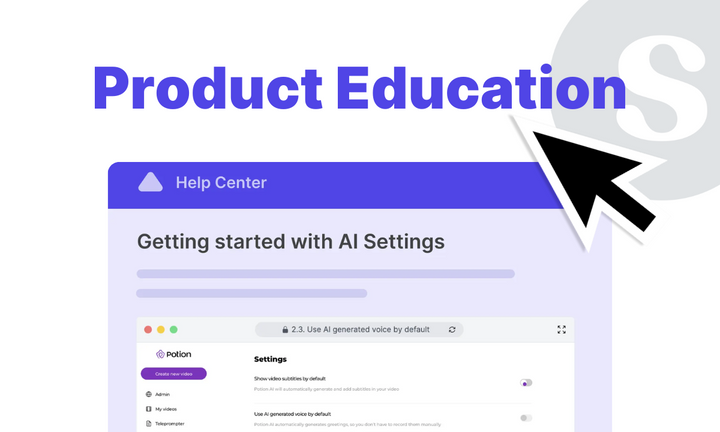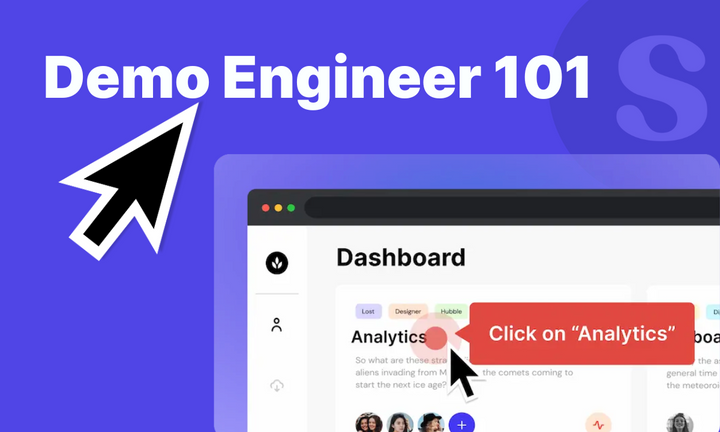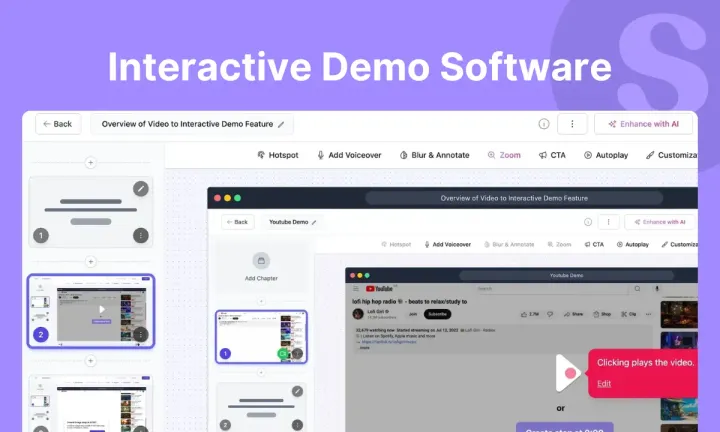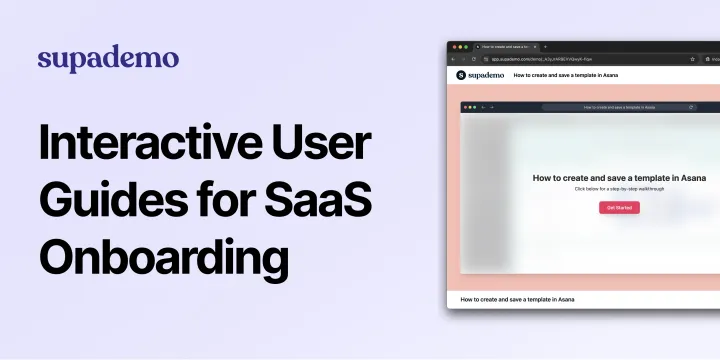Every business wants new customers. But what about the ones you already have? Customer retention marketing focuses on keeping your existing customers coming back, rather than constantly chasing new ones. It's not just smart - it's essential for sustainable growth.
According to Harvard Business Review, bringing in a new customer can cost you 5 to 25 times more than keeping an existing one, regardless of your industry.
In this guide, we'll show you exactly how to turn one-time buyers into loyal fans.
What is retention marketing?
Unlike traditional marketing that focuses on attracting new customers, retention marketing is about nurturing the relationships you've already built. Think of it as the art of turning one-time buyers into repeat customers and eventually into brand advocates.

Retention marketing goes beyond just sending promotional emails or discount codes. Whether it's personalized product recommendations, loyalty rewards, or helpful content that adds value to their experience - retention marketing encompasses every strategy that helps maintain and strengthen your customer relationships.
• Offering loyalty programs
• Sending personalized emails
• Implementing responsive customer service
• Providing exclusive offers or discounts to existing customers
We'll discuss these strategies in detail in the upcoming sections.
Customer retention marketing vs. customer acquisition
Getting new customers is different from keeping existing ones. Let's break it down:
- Customer acquisition is about finding new customers. It's when you run ads, create marketing campaigns, or offer special deals to attract people who've never bought from you before.
- Customer retention marketing focuses on keeping your current customers happy and coming back. Think welcome emails after their first purchase, loyalty rewards, or checking in to see if they need help with your product.
Both matter, but here's the thing - finding new customers costs way more than keeping your current ones. In fact, it can cost 5 to 25 times more to acquire a new customer than to retain an existing one.
What's a good retention rate in marketing?
Let's talk real numbers. While everyone wants sky-high retention rates, what's considered "good" varies significantly by industry. Here's what the data tells us:
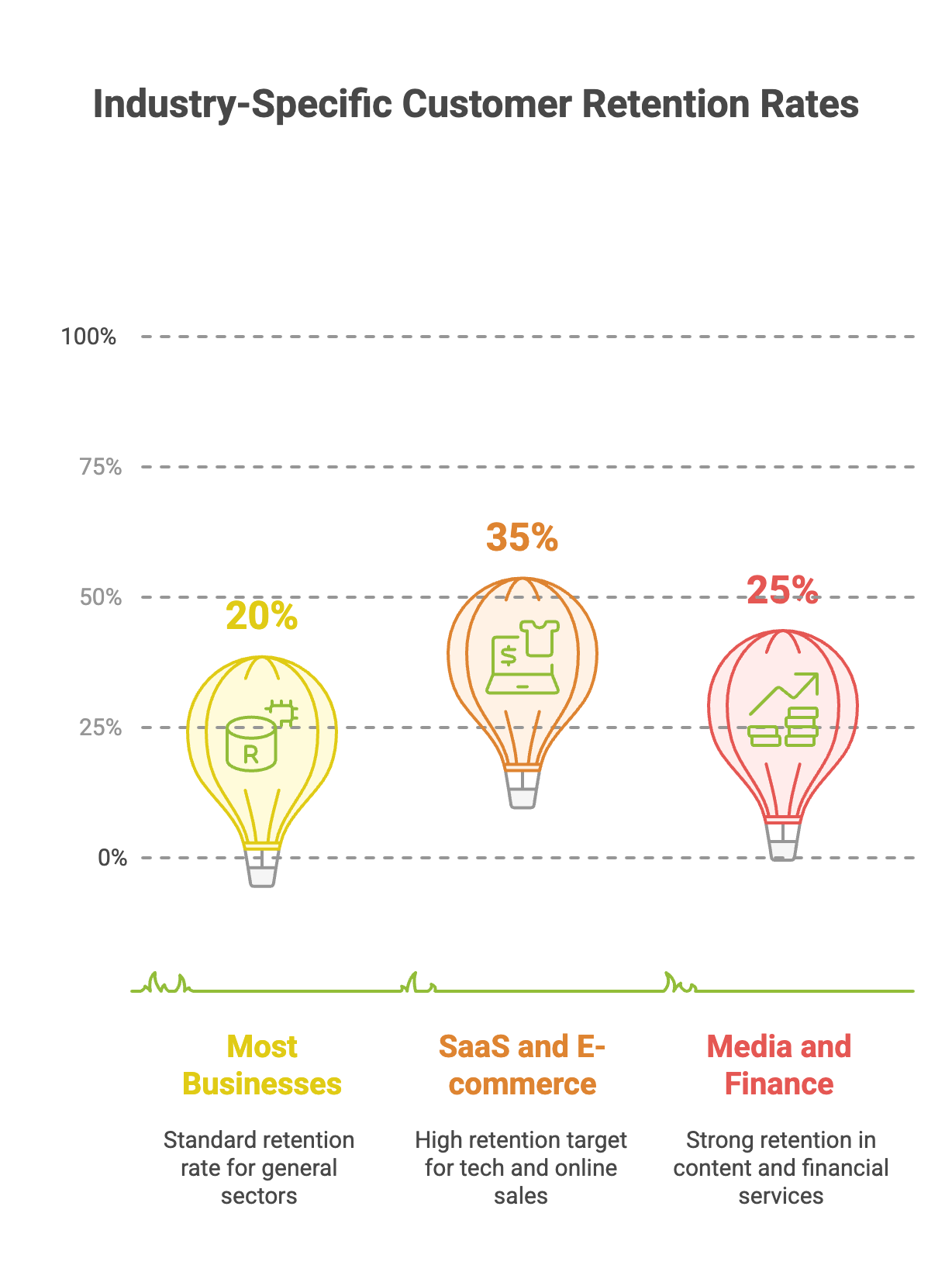
For most businesses, keeping 20% of your customers after 8 weeks is pretty standard. But if you're in SaaS or e-commerce, you should aim higher - the top performers in these industries maintain over 35% retention at the 8-week mark. Media and finance companies typically see strong retention too, with the best performers hitting over 25%.
But here's the thing - these numbers aren't set in stone. Your "good" retention rate depends on your specific business model. If you're selling software that people use daily, you'll naturally see higher retention than a business selling products people buy once a year. The key is to track your own retention rates over time and focus on steady improvement.
Importance of customer retention marketing in business growth
“If you are not retaining your customers, even at current revenue rates, then you have to run faster and faster and faster”
- - Shantanu Narayen, Adobe CEO
In the business world, one of the key components for sustainable growth is maintaining and growing and satisfied customer base – measured by metrics like NRR, churn, and revenue per user.

Here's a reality check: customer acquisition costs have skyrocketed by 60% in the last five years.

For SaaS companies, this means spending more and more money just to get new users through the door. The surge isn't surprising - with more companies competing for the same customers and constantly changing algorithms on platforms like Google and Facebook, getting noticed is becoming increasingly expensive.
But here's where it gets interesting - keeping your existing customers costs significantly less than chasing new ones. We're talking about spending 5 to 25 times less on retention compared to acquisition. The numbers tell an even more compelling story: customers who have positive experiences end up spending 140% more over time compared to those who don't.
Think about your SaaS business for a moment. Every time a customer renews their subscription, you're not just securing revenue - you're building a foundation for sustainable growth. And if you're wondering whether loyalty programs work - they absolutely do. About 80% of Americans are part of at least one loyalty program, and these programs boost repeat purchases by 60%.

The math is simple: higher retention rates mean more predictable revenue, lower marketing costs, and better customer lifetime value.
When you nail this, you're not just retaining customers - you're building a growth engine that powers your entire business.
Benefits of customer retention marketing
Customer retention marketing holds immense power in boosting both the growth and stability of an enterprise. The advantages offered by a robust customer retention marketing strategy are numerous and considerable.
Here are some of the key benefits of effective retention marketing:
1. Increased customer loyalty and repeat business
Loyalty, in most cases, leads to repeat business, which is a lifeline for any organization. Customer retention marketing primarily focuses on ways to keep existing customers happy and satisfied with the products or services offered. In some ways, it's a win-win situation. When customers feel valued and appreciated, they are more likely to:
- Remain loyal to the brand
- Continue purchasing products or services
- Advocate for the brand within their networks
This gives businesses a solid foundation of repeat customers, fostering a more predictable and stable revenue stream that compliments the existing sales pipeline.

2. Cost-effectiveness compared to acquiring new customers
That's why a focus on customer retention marketing can save a business considerable resources while still driving sales.
3. Opportunity for upselling and cross-selling
Existing customers present a tremendous opportunity for upselling and cross-selling. Because they are already familiar with your brand, they are more likely to take a chance on a new product or service, or upgrade their current package.
This not only serves to increase your revenue but also diversifies the portfolio of products or services each of your customers is connected to, deepening their engagement with your brand.
4 strategies for effective customer retention marketing
Here are some customer retention strategies that have proven very effective for businesses:
1. Personalized communication and customer segmentation

By breaking down your consumer base into smaller, more targeted segments, you can tailor your communication and marketing strategies to fit the specific needs and preferences of each group.
This includes sending personalized emails using dynamic variables, providing tailored product recommendations, or even offering personalized discounts.

• Sending personalized emails that consider customer purchase history or behavior can significantly increase customer engagement.
• Offering product recommendations based on a customer's browsing or purchasing history can also make them feel valued and understood.
2. Rewards and loyalty programs
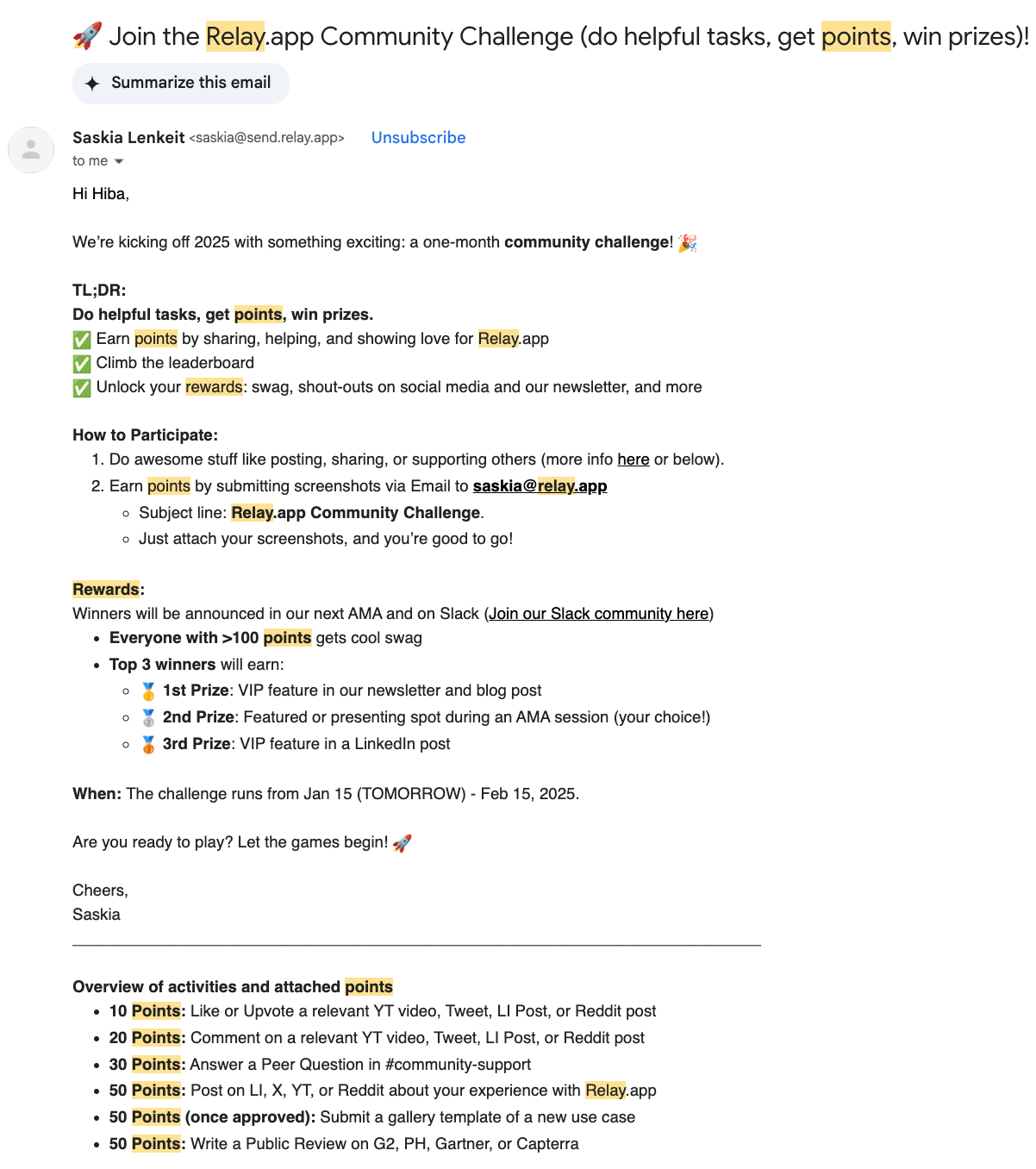
These programs give customers more reasons to stick with your brand. Essentially, customers earn rewards each time they purchase, leading to free products, discounts, or other attractive incentives for being loyal customers.
• Tiered loyalty programs, where customers get more benefits as they reach higher purchase levels, are particularly effective.
• Similarly, referral programs can work wonders for retaining customers since they get a chance to receive rewards when they refer new customers.

3. Outstanding customer service
Furthermore, according to Salesforce Research, If the company’s customer service is excellent, 78% of consumers will do business with them again even after a mistake.
Customers are more likely to stay loyal to a brand that offers excellent customer support. This includes effective product onboarding systems, quick response times when customers have queries or issues, empathetic handling of complaints, and exceeding customer expectations.
Using specific frameworks, or tools like interactive demos for customer success can be paramount to ensure customers find the success they want to see within your product.
• Offering multiple channels of communication such as phone support, live chat options, and email can improve your accessibility.
• Remember, the added value of a positive customer service experience can lead to significant word-of-mouth referrals.
4. Regular follow-up and feedback collection
Regularly following up with your customers makes them feel cared about, adds a personal touch, and presents a chance to address any concerns they might have. Feedback collection, on the other hand, helps businesses understand what customers like, what they dislike, and what improvements they look forward to experiencing.
To streamline this process, businesses could generate a QR code, making it simple for their customers to provide feedback instantly.
This feedback can be used to improve your product, validate new features, and fix critical bugs and issues.
• Surveys and feedback forms are great ways to collect insights.
• Personalized follow-up messages or calls can also have a significant impact on improving customer loyalty.
By incorporating some of these strategies into your retention plan, you can significantly enhance customer retention, loyalty, and engagement, thus paving the way for impressive business growth.
Key metrics that matter in retention marketing
Want to know if your retention efforts are actually working? Here are the essential metrics you should track:
- Customer Retention Rate: Simply put, this shows how many customers stick around. If you start with 100 customers and end up with 85 (excluding new sign-ups), your retention rate is 85%.
- Monthly Recurring Revenue (MRR): Think of this as your monthly predictable income. If you have 100 customers paying an average of $50 per month, your MRR is $5,000. This number helps you understand your stable revenue base.
- Customer Lifetime Value (CLV): This tells you how much a customer is worth to your business over time. For example, if a customer spends $100 monthly and stays for 2 years, their CLV is $2,400. The higher this number, the better your retention strategy is working.
- Net Promoter Score (NPS): This measures how likely your customers are to recommend you. It's simple: ask customers to rate you from 0-10. Those giving 9-10 are promoters, 0-6 are detractors. Subtract the percentage of detractors from promoters to get your NPS.
- Revenue Churn Rate: This shows how much revenue you're losing each month from existing customers. Lower is better - it means you're keeping your valuable customers happy.
- Customer Satisfaction Score (CSAT): Want to know if your customers are happy? This is your metric. After customer interactions, ask them if they're satisfied. The higher the percentage of positive responses, the better you're doing.
- Existing Customer Revenue Growth Rate: This shows how well you're growing revenue from current customers - through upgrades or additional services. A positive growth rate means your customers see enough value to invest more in your product.
Remember: These metrics work together to give you a complete picture of your retention success. No single number tells the whole story, but together, they help you understand where to focus your efforts.
Tools for implementing customer retention marketing
Successful customer retention marketing isn't just about having a great product or service. It's about using the right tools and techniques to engage and delight your existing customer base.
Here are some of the important methods businesses use to implement customer retention marketing:
1. CRM software and customer data management
Effective customer retention relies on a deep understanding of your customers, which is where Customer Relationship Management (CRM) software comes in. CRM not only stores all your customer information; it analyzes customer behavior and spending habits, allowing you to create highly personalized marketing campaigns.
Additionally, using CRM tools to manage customer data helps you to identify high-value customers, create personalized messages and tailor your services to better align with their needs.
• Detailed customer profiling
• Behavioral tracking and segmentation
• Targeted campaigns based on customer data
Popular tools for CRM include HubSpot, Close.io, and Salesforce.
2. Email marketing and automation
Email marketing remains one of the most effective retention marketing tools. Once a customer has made their first purchase, email marketing can be used to keep them engaged, informed and interested in your products or services. Automation plays a crucial role here, allowing for scheduled sending of emails based on specific consumer behavior or milestones like birthdays or anniversaries of their first purchase.
However, to ensure your email marketing efforts are effective, it's essential to perform a regular domain health check to improve deliverability and prevent your emails from landing in the spam folder.
• Send personalized emails based on customer preferences
• Use email automation for timely communication
• Regularly offer exclusive deals or valuable content to subscribers
Popular tools for CRM include Customer.io, MailChimp, and HubSpot.
3. Product onboarding and enablement
Interactive demos and product tours are digital, hands-on experiences that allow users to explore and interact with a product or service before fully committing to it. They provide a guided, immersive introduction to a product's features and functionality.

Here's an example of an interactive demo tour -
They are helpful for enabling new and existing users, onboarding them, and improving retention for a few distinct reasons.
- Enhanced user engagement: Interactive tours are more engaging than static content, actively involving users in the learning process. For existing users, interactive tours can introduce new features or advanced functionality, keeping them engaged and up-to-date.
- Improved product adoption: They allow users to see the product in action, helping them grasp its value proposition and key features more effectively. This helps users understand how to use the product effectively, increasing the likelihood of successful adoption.
- Personalized experience: Tours can be tailored to specific user needs or roles, providing a more relevant and impactful introduction to the product.
- Self-paced learning: Users can explore the product at their own pace, which is particularly helpful for complex products or features.
Using interactive product demo platforms like Supademo, companies can create a more effective, engaging, and personalized onboarding experience that not only helps new users get started but also keeps existing users engaged and informed about new features and capabilities.
Case studies of successful customer retention marketing campaigns
Customer retention marketing is not just about the theory, it's about taking a practical approach to keep your customers engaged and satisfied.
Let's look at some case studies of successful customer retention marketing campaigns run by well-known brands.
1. Starbucks Rewards Program

Starbucks has cleverly designed its Rewards Program to increase both customer loyalty and customer engagement. It works on a simple premise – the more you buy, the more rewards you earn.
However, what truly sets it apart is the personalized experiences, free in-store refills, and Birthday rewards - creating an emotional connection with their customers.
- Engages customers with redeemable rewards and personalized offers.
- Encourages visits during non-peak hours for extra points.
- Drives customer loyalty by offering exclusive member events and previews.
2. Amazon Prime Membership

Amazon Prime is a masterclass in customer retention marketing. For a nominal annual or monthly fee, Amazon Prime offers members a slew of benefits such as free two-day shipping, unlimited streaming of movies, TV shows, and music, and exclusive access to books.
These perks don't just increase customer loyalty, but also encourage customers to shop more frequently from Amazon.
- Increases customer loyalty with free shipping and exclusive member-only deals.
- Encourages purchase frequency with services like Prime Video and Amazon Music.
- Retains customers with exclusive access to new products and early sale access.
3. HubSpot's Customer Platform
One software company with a successful customer retention marketing campaign is HubSpot.

HubSpot has implemented a multi-faceted customer retention strategy that focuses on providing value, education, and personalized experiences to their users. Their approach includes
- Comprehensive onboarding: HubSpot prioritizes personalization from the start, offering tailored tutorials and resources closely related to each customer's preferences and needs during the onboarding process.
- Community building: HubSpot has created a strong community around its product, fostering user engagement and peer-to-peer support.
- Customer service tools: HubSpot has adopted robust customer service tools to support their growing user base. This includes a CRM system to record customer interactions, create support tickets, and centralize customer service operations.
- Educational content: The company consistently produces high-quality, educational content through their blog, academy, and certification programs. This helps customers get more value from HubSpot's products while positioning the company as an industry thought leader.
In each of the examples above, the brands have carefully considered what incentives would engage and retain their customers, stoking customer loyalty and fueling business growth.
Challenges and solutions in customer retention marketing
Customer retention marketing is not a walk in the park. It comes with its fair share of challenges and hurdles. However, with the right comprehension and application of solutions, businesses can surmount these obstacles and capitalize on the potential it offers.
Here are some of these challenges and their plausible solutions.
1. Increasing competition and customer expectations
The digital age has amplified competition, putting customers in the driver's seat. Not only do businesses have to differentiate themselves from their competitors, but they also need to consistently meet and surpass customer expectations.
Some solutions to handle this include:
- Be proactive in identifying and adapting to market trends.
- Leverage customer data to understand their needs better and create personalized experiences.
- Foster a customer-centric culture within the organization that values relationship building and continuous improvement.
2. Tailoring strategies based on different customer segments

No two customers are the same - thus adopting a one-size-fits-all approach can lead to customer disengagement. Businesses often struggle with tailoring strategies that cater to diverse customer segments. Here are some strategies that can help:
Some solutions to handle this include:
- Implement customer segmentation based on demographics, behavior, or purchase history
- Customize marketing messages and offers to these unique segments.
- Periodically review these segments to ensure you adjust your strategies as needed.
3. Maintaining brand consistency across various touchpoints
In the hustle to follow omnichannel marketing, maintaining brand consistency can be a daunting task. A consistent brand experience makes customers feel understood and valued, fostering their loyalty. It increases trust and develops a profound emotional connection that more often than not results in repeat business.
- Ensure all your customer touchpoints, whether social media, email, or in-person, communicate consistent branding messages.
- Monitor all brand-related elements closely, including visual aesthetics, tone of voice, and core brand messages.
- Regular training and updates for employees to foster understanding and commitment towards delivering consistent brand experiences.
Through thoughtful planning and strategic implementation of customer retention marketing, businesses can surely overcome these challenges and foster stronger connections with their customers, eventually leading to significant business growth.
Wrapping up!
Customer retention marketing is a critical framework to consider when you're trying to retain and existing your customer base.

By fostering customer loyalty and engagement, businesses not only maintain their existing customer base but also increase their chances of getting referrals.
The more loyal customers you have, the stronger your business becomes. The strategies shared in this blog can serve as a beneficial starting point for any business looking to tap into the power of customer retention.
Ready to start improving your craft across your organization? Try using interactive demos for customer success, product onboarding, or customer support to better retain and grow your customers.


